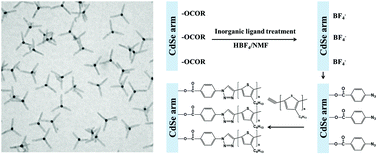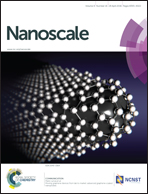Semiconducting organic–inorganic nanocomposites by intimately tethering conjugated polymers to inorganic tetrapods†
Abstract
Semiconducting organic–inorganic nanocomposites were judiciously crafted by placing conjugated polymers in intimate contact with inorganic tetrapods via click reaction. CdSe tetrapods were first synthesized by inducing elongated arms from CdSe zincblende seeds through seed-mediated growth. The subsequent effective inorganic ligand treatment, followed by reacting with short bifunctional ligands, yielded azide-functionalized CdSe tetrapods (i.e., CdSe–N3). Finally, the ethynyl-terminated conjugated polymer poly(3-hexylthiophene) (i.e., P3HT–![[triple bond, length as m-dash]](https://www.rsc.org/images/entities/char_e002.gif) ) was tethered to CdSe–N3 tetrapods via a catalyst-free alkyne–azide cycloaddition, forming intimate semiconducting P3HT–CdSe tetrapod nanocomposites. Intriguingly, the intimate contact between P3HT and CdSe tetrapod was found to not only render the effective dispersion of CdSe tetrapods in the P3HT matrix, but also facilitate the efficient electronic interaction between these two semiconducting constituents. The successful anchoring of P3HT chains onto CdSe tetrapods was substantiated through Fourier transform infrared spectroscopy and nuclear magnetic resonance spectroscopy measurements. Moreover, the absorption and photoluminescence studies further corroborated the intimate tethering between P3HT and CdSe tetrapods. The effect of the type of bifunctional ligands (i.e., aryl vs. aliphatic ligands) and the size of tetrapods on the device performance of hybrid organic–inorganic solar cells was also scrutinized. Interestingly, P3HT–CdSe tetrapod nanocomposites produced via the use of an aryl bifunctional ligand (i.e., 4-azidobenzoic acid) exhibited an improved photovoltaic performance compared to that synthesized with their aliphatic ligand counterpart (i.e., 5-bromovaleric acid). Clearly, the optimal size of CdSe tetrapods ensuring the effective charge transport in conjunction with the good dispersion of CdSe tetrapods rendered an improved device performance. We envision that the click-reaction strategy enabled by capitalizing on two consecutive effective ligand exchanges (i.e., inorganic ligand treatment and subsequent bifunctional ligand exchange) to yield intimately connected organic–inorganic nanocomposites provides a unique platform for developing functional optoelectronic devices.
) was tethered to CdSe–N3 tetrapods via a catalyst-free alkyne–azide cycloaddition, forming intimate semiconducting P3HT–CdSe tetrapod nanocomposites. Intriguingly, the intimate contact between P3HT and CdSe tetrapod was found to not only render the effective dispersion of CdSe tetrapods in the P3HT matrix, but also facilitate the efficient electronic interaction between these two semiconducting constituents. The successful anchoring of P3HT chains onto CdSe tetrapods was substantiated through Fourier transform infrared spectroscopy and nuclear magnetic resonance spectroscopy measurements. Moreover, the absorption and photoluminescence studies further corroborated the intimate tethering between P3HT and CdSe tetrapods. The effect of the type of bifunctional ligands (i.e., aryl vs. aliphatic ligands) and the size of tetrapods on the device performance of hybrid organic–inorganic solar cells was also scrutinized. Interestingly, P3HT–CdSe tetrapod nanocomposites produced via the use of an aryl bifunctional ligand (i.e., 4-azidobenzoic acid) exhibited an improved photovoltaic performance compared to that synthesized with their aliphatic ligand counterpart (i.e., 5-bromovaleric acid). Clearly, the optimal size of CdSe tetrapods ensuring the effective charge transport in conjunction with the good dispersion of CdSe tetrapods rendered an improved device performance. We envision that the click-reaction strategy enabled by capitalizing on two consecutive effective ligand exchanges (i.e., inorganic ligand treatment and subsequent bifunctional ligand exchange) to yield intimately connected organic–inorganic nanocomposites provides a unique platform for developing functional optoelectronic devices.


 Please wait while we load your content...
Please wait while we load your content...